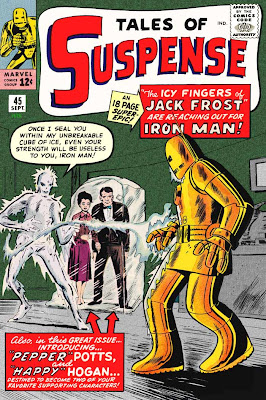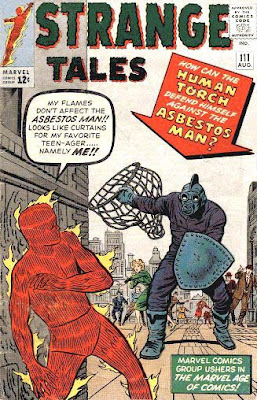
FANTASTIC FOUR #17
This one picks up right where the previous issue left off, with the FF and Ant Man returning to normal size after their adventure in a sub-atomic world. Hank takes off while Reed and the others begin a search for Doctor Doom.
But their arch-enemy manages to find them first. He kidnaps Alicia, then (while based in a large airship) attempts to bring the United States to its knees by disrupting electrical power across the nation.
He also rings his ship in disintegrator beams tuned to the molecular structures of the FF. But Reed has a way to deal with that—he develops a formula to turn the Thing back into Ben Grimm (thus altering his molecular structure) long enough for Ben to sneak aboard the airship and wreck its defenses.
The story plods along a little at first, taking quite a few pages to set up the main plot. But once our heroes are aboard the airship, we get some nifty action stuff. This includes Sue using her invisibility to go one-on-one with Doom for a couple of pages. I’ve claimed in previous reviews that Sue was too underpowered to be of much use in the early issues of the FF—that she really wasn’t that effective until she got her force field powers. But reading through these early stories again is making me change my mind. It did take Stan and Jack a little while to figure out how to use her, but by now she’s getting her share of awesome moments in pretty much every issue.
Other strong points include the scene in which Reed races to develop the formula needed to get Ben aboard the ship; a nice moment in which Ben admits he trusts Reed with his life; and Ben’s almost-panicked response when he first learns that Alicia is in trouble.
Anyway, it all ends with Alicia safe and Doom defeated. Doom leaps to his apparent death out of the ship rather than admit his defeat, but this is a guy who has survived being thrown into deep space and shrunk down to sub-atomic size. I think we can safely assume he’ll survive a simple thing like plunging 20,000 feet to the ground.

TALES TO ASTONISH #46
Hank and Janet take a vacation to the Greek islands, but a hero’s work is never done. They run into a giant Cyclops that’s been kidnapping sailors.
It soon turns out that the Cyclops is a giant robot, being used by yet another race of invading aliens. Using a flying ant as a mount (the first time he employs that trick, I believe), Ant Man flies into the robot through its mouth. Fiddling with the circuits, he gains control of the Cyclops and turns it against the aliens. So much for THAT problem.
Aside from the over-used “invading aliens” trope, this is a fun little story. Don Heck’s art work looks a little stiff (as it often does), but his Cyclops is kinda creepy looking and the action is effectively choreographed.

TALES OF SUSPENSE #44
While helping an archeologist friend in Egypt, Tony Stark encounters an ancient mummy who’s not quite dead yet. The guy actually turns out to be a sorcerer who put himself into suspended animation for 2000 years to escape his enemies. Using a magic spell, he brings Tony back in time, intending to force him to use modern science to help defeat Cleopatra’s army and take over the country.
But Tony changes into Iron Man and gets away. He then drives off an invading Roman army and saves the beautiful Cleopatra. After this, he helps defeat the time-traveling villain.
Don Heck is the artist on this issue as well and he does some fun visuals when Iron Man fights off the Romans. (I can’t help but wonder, though. Isn’t Tony messing up the proper flow of history?) Tony gets his props as a ladies man as well, turning down an offer to marry Cleopatra before using a magic charm to return to the present.
Like the previous issue, the action scenes are marred a little by the fact that Iron Man has such an easy time winning. The nifty visuals make up for this, though. And next issue, Iron Man will finally get something his book has been sorely lacking—a cast of regular supporting characters.
Next week, we’ll finish up August with a peek at Thor, the Human Torch and Dr. Strange.





















